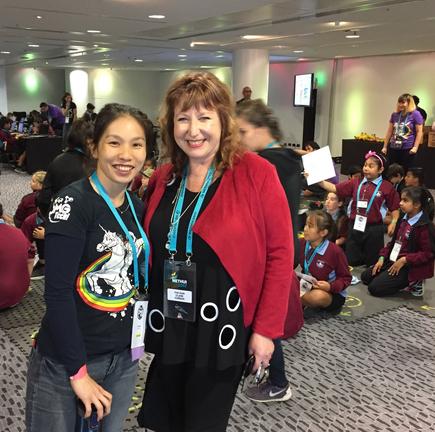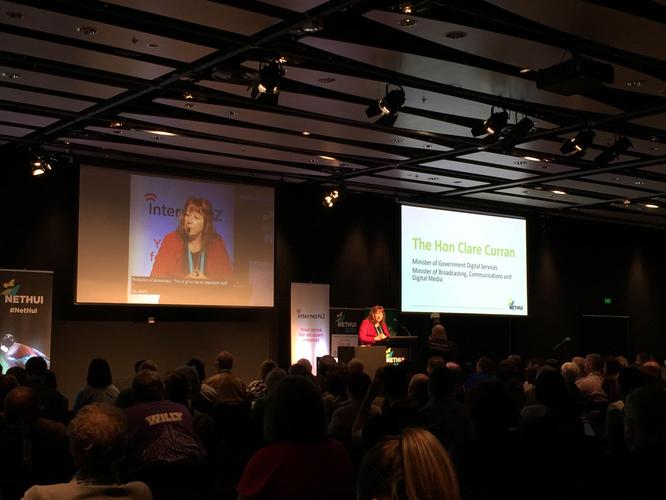We can grow the ICT sector and make it inclusive at the same time
Before the yearend, New Zealand will have a framework for appointing a national chief technology officer (CTO).
Clare Curran, minister for government digital services, broadcasting, communications and digital media, says the CTO appointment will be one of the priorities of her role in the 100 days following the election.
“The feedback from industry and community is we need this,” she tells CIO New Zealand. “We are doing it in science, we can do it in technology as well.”
Curran reveals she has already sought advice on how the CTO position can be created, its reporting functions and chief objectives, in her keynote at the 2017 NetHui.
We will “lay the groundwork for establishing the position of the chief technology officer for New Zealand with responsibility for preparing and overseeing a national digital architecture or roadmap for the next five to 10 years,” she told the conference delegates.
The focus of this role will include fiber optic capabilities; 5G, 6G, 7G and beyond, mobile technology, artificial intelligence, robotics, autonomous vehicles, gaming and Internet of Things.
 Credit: Supplied
Credit: Supplied Having someone, or a small group, tasked with looking to the future and helping New Zealand become an effective and fair digital nation is critical
She says her other priorities are creating the blueprint for digital inclusion, a framework for establishing RNZ as the centrepiece for full non-commercial public media services for all Kiwis; establishing a process of proactive release of government information and a framework for strengthening citizens' rights in the digital environment.
She plans to convene advisory groups to work with leading figures in each area from inside government, industry, Maoridom, local government, NGOs and community groups.
Their brief is to build a consensus view of the current state of the sector and scenarios for the future, and what would be required from government to achieve the latter.
“We can grow the ICT sector and make it inclusive at the same time,” she says. “We don’t need to and can’t afford to exclude anyone from the benefits of digital connectivity.”
She says addressing the digital divide is a priority for the government. The Otago University Social Deprivation Index has identified a lack of internet access at home, as the highest weighted factor affecting social deprivation for working age New Zealanders.
“Our position is New Zealanders must have access to technology as a right, regardless of income or geography.

Change is occurring at an unprecedented rate and we need to create a strategy that addresses the needs of future Kiwi families
“If we aren’t using it effectively, the whole economy suffers. It is up to industry and government working together to improve deployment of technology and increase productivity, create new jobs and reskill old ones, to make New Zealand more competitive against global technology multinationals in our domestic market.”
She says the coalition government is committed to ICT being the second largest contributor to GDP by 2025.
“I think we can do it earlier than that,” she says.
She believes improved engagement and genuine collaboration between government and industry, community groups and NGOs are important.
“New Zealand is much too small to have government and industry working on separate objectives,” she says. “We need a process of co-design where we can deliver on an agreed view on two basic questions: What is already being done, what is it that government can do to help?”
Running a government is different than building a startup, she says. But there are benefits from modern design thinking such as collaboration, focus on prototyping and speed that can be used in these discussions.
“There are four million untapped collaborators in our society,” she says.

This role ought to focus on both the opportunities and challenges of technology: economic growth as well as job displacement
A welcome move
Business technology leaders have reacted positively to the announcement by Curran, that the appointment of a national chief technology officer will be one of her top priorities.
NZTech CEO Graeme Muller says the organisation is looking forward to doing whatever it can to help the Minister get the structure and role in place sooner rather than later.
“There are a variety of opinions about what such a role should do and what structure it should sit in,” says Muller.
“For example, should it be a government department or a public-private partnership?
“But what is clear is that having someone, or a small group, tasked with looking to the future and helping New Zealand become an effective and fair digital nation is critical.”
Muller says NZTech has been working with the Department of Internal Affairs and the Ministry of Business, Innovation and Employment on a summit in February, 2018. The aim is to bring together some of the leading digital countries with New Zealand’s business, social and government leaders, to develop a vision for a truly digital nation by 2030.
“This will be an excellent opportunity for a CTO to connect with world leaders in this space and engage with leaders from across New Zealand to identify priorities for a CTO office as it develops a national digital roadmap,” says Muller.
“The appointment of a government CTO is a great idea,” says David Kennedy, chair of NZTechLeaders.
“Change is occurring at an unprecedented rate and we need to create a strategy that addresses the needs of future Kiwi families.”
NZTechLeaders was formed early this year by a group of technology, digital and ICT focused-executives from leading organisations to help define, communicate and promote initiatives around the use of technology.
He says the advisory group recently met to discuss the impact of artificial intelligence and robotic automation. (Click here for a link to the TechLeaders Executive Discussion Paper on Industry, education and the workplace of tomorrow)
“We welcome the opportunity to work with the government CTO on these issues and other digital and technology initiatives,” says Kennedy, who is also the CIO at Transaction Services Group.
NZTechLeaders recommendations include helping the public understand automation by creating and promoting information directed at families, to provide context on the future to help them prepare. This will reduce fear inducing messaging about people losing their jobs and ‘robots taking over’.
The group is also recommending the creation of a website where an existing job role is entered, for information on how likely it is to be automated. A similar initiative has been devised by the BBC in the United Kingdom.
They also cite the need for industry to develop ways to promote the digital technology curricula and better engage industry and its digital employees in programmes to help support teachers and students. This could include mentoring, competitions and work experience.

There are four million untapped collaborators in our society
International perspective
The national CTO role should “maintain a global view with respect to the opportunities that New Zealand can capitalise upon as a technologically progressive nation,” says Jennifer Byrne, chief technology officer of global industry for Microsoft.
“Planning for economic growth must address education in a traditional sense, but also in non-traditional formats in order to address the potentially disruptive effects it may have on the workforce of the future,” says Byrne.
“In other words, this role ought to focus on both the opportunities and challenges of technology: economic growth as well as job displacement.
“Finally, strict adherence to the security and privacy needs of both New Zealanders, as well as consumers of technology from New Zealand will be a fundamental requirement for ensuring not only continuous adoption of technology, but that positive societal outcomes are also achieved.
“There are likely several measures that would be required in order to ensure neutrality over time, not the least of which would be a thoughtful approach to the level of influence of the CTO and the supporting organisational structure for this role,” says Byrne, who was recently in New Zealand.
“Quite often CTOs act as a bridge between functions that are primarily, or only, IT in nature, and business or other non-IT functions.
“That is in fact the way in which this role is often able to think strategically, because technology for its own sake cannot be guaranteed to provide a positive and meaningful outcome.
“Yet, without a deep understanding of technology, there is a real danger that implementation plans for broad societal outcomes as defined throughout other Ministries are either not structured correctly or miss opportunities that technology could realise.
“In general, the scope of this role should include a primary focus on outcomes and an adherence to a set of principles and practices, which are transparent and reflect the values of New Zealand government and society.”
She believes though a solution to address the question of areas to invest in terms of e-government, education and technology can't be successfully targeted within a single role.
“A better approach may be to accept and acknowledge bias and address it through a governance structure that requires input from many different and diverse stakeholders; and with as much transparency in both principles and practices as is possible."
Growing the technology sector, meanwhile, requires continuous, sustained engagement and collaboration across many sectors: education, business, local government, as well as tax and other regulatory bodies, she says.
“For New Zealand, it is important to be thoughtful about its role in the broader regional and global economies, such that growth is tuned to more than just local demand.”
Strong commentary from Jennifer Byrne on the need for a government CTO.https://t.co/YOPj9ei0Nd
— Barrie Sheers (@BarrieSheers) November 20, 2017

We _must_ grow the #ICT sector, and one of the best ways is to make it more #inclusive (as well as that being ethically required) :)
— aimee whitcroft (@teh_aimee) November 12, 2017
cc @clarecurranmp @CIO_NZ https://t.co/5g7Seir4is
Send news tips and comments to divina_paredes@idg.co.nz
Follow Divina Paredes on Twitter: @divinap
Follow CIO New Zealand on Twitter:@cio_nz
Join the CIO New Zealand group on LinkedIn. The group is open to CIOs, IT Directors, COOs, CTOs and senior IT managers.






